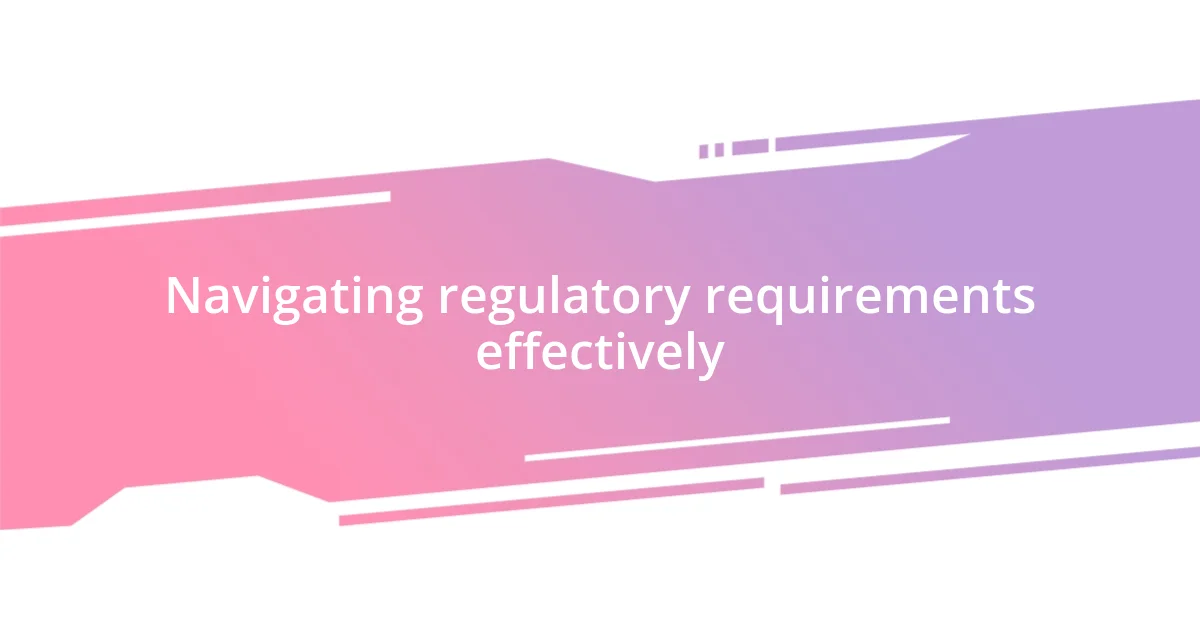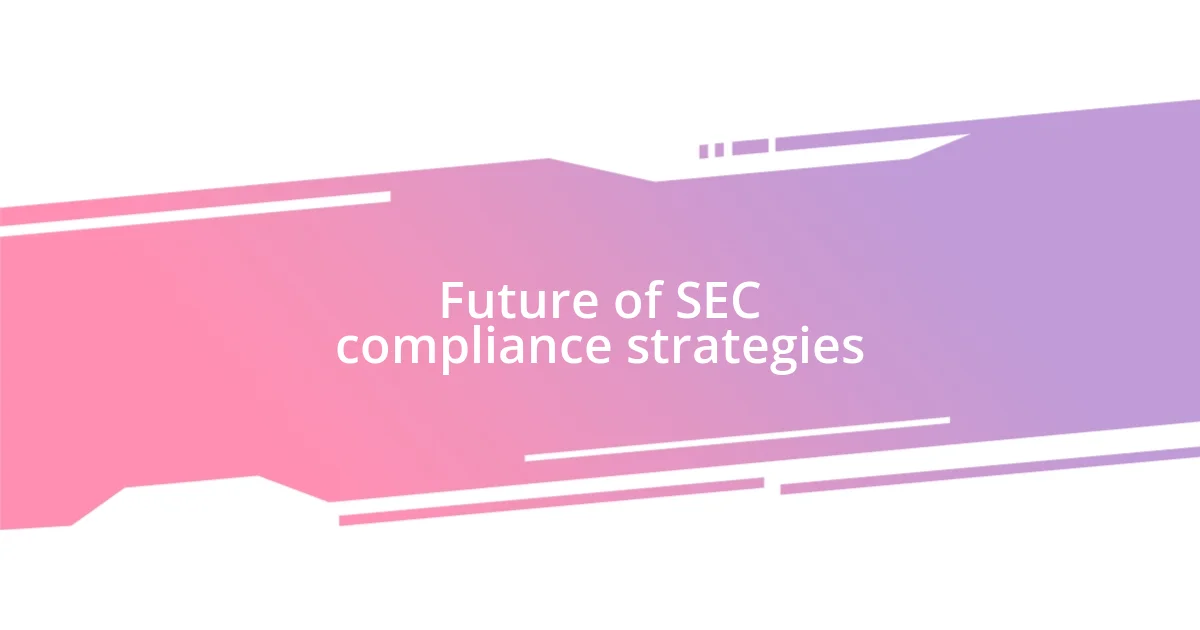Key takeaways:
- Embedding compliance into company culture fosters trust and transforms compliance from a burden into a strategic advantage.
- Establishing clear communication and collaboration across departments is essential for effective compliance practices and to prevent oversights.
- Utilizing technology and maintaining a proactive approach to regulatory changes are key to navigating the complexities of SEC compliance successfully.

Understanding SEC compliance basics
Understanding SEC compliance starts with recognizing its purpose: to protect investors and ensure fair, orderly markets. When I first encountered the SEC’s regulations, I felt overwhelmed by the sheer volume of rules and guidelines. How do organizations keep up with all of this? Well, it’s about integrating compliance into the company culture and operational processes.
I remember attending a seminar where they stressed the importance of transparency in reporting. This really struck a chord with me. The concept of trust in business is paramount, and the SEC compliance framework is designed to foster that trust through rigorous oversight. Isn’t it interesting how that adds a layer of responsibility to our day-to-day operations?
Navigating SEC compliance isn’t just about ticking boxes; it’s about understanding the implications of those rules on your business strategy. I’ve seen companies thrive because they embraced compliance as a strategic advantage rather than a burden. Have you ever thought about how compliance could elevate your business rather than limit it?

Common SEC compliance challenges
When I think about the challenges of SEC compliance, one that stands out is the complexity of reporting requirements. I remember grappling with the nuances of Form 10-K and Form 10-Q disclosures. Each quarter felt like a mountain to climb, filled with intricate details that had to be accurate to avoid penalties. It’s not just about hitting deadlines; it’s about ensuring that every figure reflects the true state of the company, which adds a layer of pressure that can be stressful.
Another common challenge I faced was the ever-evolving nature of regulations. Just when you think you’ve mastered the current requirements, the SEC issues new guidelines or amendments. I can’t tell you how many times my team had to scramble to adapt to these changes. It’s like trying to hit a moving target while also ensuring that previous filings remain compliant.
Finally, I believe that internal communication often poses its own hurdles. I have seen firsthand how silos within organizations can lead to inconsistent compliance practices. For instance, when departments don’t share information, it puts the entire compliance framework at risk. I recall a situation where a lack of communication resulted in conflicting interpretations of guidelines among teams, causing unnecessary confusion and frustration. This experience taught me that fostering open lines of dialogue is crucial for achieving effective compliance across the board.
| Challenge | Description |
|---|---|
| Reporting Requirements | Complex forms and filings can overwhelm teams with detailed accuracy demands. |
| Evolving Regulations | Frequent updates require constant vigilance and adaptability from compliance teams. |
| Internal Communication | Silos within organizations can lead to inconsistent compliance practices and confusion. |

Navigating regulatory requirements effectively
As I navigated the intricate world of SEC compliance, I discovered that staying ahead of regulatory requirements requires more than just meeting standards; it necessitates a proactive approach. I remember vividly how my team adopted a compliance calendar that mapped out key filing dates and regulatory updates. This simple tool transformed our workflow. It enabled us to anticipate requirements and prioritize tasks more effectively, which alleviated much of the stress associated with last-minute scrambles.
To ensure my organization remained compliant, I implemented practices that fostered clarity and collaboration. Here are some strategies that worked for me:
- Regular Training Sessions: These keep everyone updated on the latest regulations and best practices, turning compliance into a team effort.
- Cross-Departmental Meetings: These allowed different teams to understand each other’s operational challenges and perspectives, leading to a unified compliance approach.
- Use of Technology: Leveraging compliance software helped automate routine tasks, freeing up time for more strategic initiatives and reducing the risk of human error.
Finding the right balance between compliance and operational efficiency became a game-changer for us. I felt a sense of relief as we created a culture where everyone understood their role in maintaining compliance. It turned from a daunting task into a shared responsibility that ultimately strengthened our business.

Implementing best practices for compliance
Implementing best practices for compliance is truly a journey I’ve experienced firsthand. One approach that worked wonders for us was the establishment of a clear escalation process for compliance issues. I remember the tension in the air during meetings when critical problems were overlooked, often leading to confusion down the line. When we created a structured pathway for raising flags, it was like turning a light on in a dimly lit room; not only did it empower team members to speak up, but it also fostered an environment of trust. How valuable is it to know that your concerns will be heard and addressed?
Another key practice I found indispensable was maintaining comprehensive documentation of procedures and decisions. At times, my team faced the repercussions of miscommunication, especially when the rationale behind a certain compliance move was lost to time. By documenting everything meticulously, we turned what could have been a chaotic scramble into a well-organized archive of insights and decisions. It felt reassuring to have that at our fingertips, especially when preparing for audits or updates.
Finally, I’ve learned that a culture of continuous improvement is essential. I recall after a particularly challenging SEC filing season, we took the time to debrief as a team. We discussed what worked, what didn’t, and how we could refine our processes. This reflection wasn’t just an exercise; it was a crucial moment of growth that helped us evolve as a compliant organization. Implementing best practices may take effort, but I assure you—the clarity and peace of mind it brings is worth every ounce of energy invested.

Lessons learned from compliance issues
Experiencing compliance challenges taught me the importance of flexibility. There were moments when our plans unraveled, often due to unexpected regulatory changes. I remember feeling a wave of frustration wash over the team during those times. However, adapting swiftly became a necessary skill. It’s amazing how a willingness to pivot can turn potential setbacks into opportunities for growth and learning.
One pivotal lesson was the significance of communication, not just within my team but across the entire organization. I vividly recall a time when a lack of information-sharing led to compliance oversights that could have been easily avoided. Trust me, nothing stings quite like the realization that better communication would have prevented a preventable mistake. Now, I prioritize open dialogue and encourage others to do the same. It creates an environment where compliance is a shared responsibility, and we all benefit from collective vigilance.
Lastly, I discovered that embedding compliance into the company culture isn’t just smart—it’s crucial. I once faced skepticism from colleagues who thought compliance was just an added layer of bureaucracy. But as we navigated the complexities together, I noticed a shift in mindset. When team members embraced compliance as a core value rather than a chore, it elevated our operations and transformed our approach. Isn’t it inspiring when people see the bigger picture and understand the role they play in protecting the organization? This change was truly a lesson in the power of perspective.

Future of SEC compliance strategies
Looking ahead, I foresee that leveraging technology will play an essential role in SEC compliance strategies. I remember when we first incorporated automated tools for monitoring compliance; it felt like upgrading from a flip phone to a smartphone. The efficiency and accuracy improvements were significant. Can you imagine having real-time insights at your fingertips? It certainly changes the game.
As regulations evolve, I believe that fostering a culture of adaptability within teams will be crucial. In my experience, teams that remain open to learning and adapting are more resilient in the face of compliance challenges. Reflecting on a time when a sudden regulatory update forced us to rethink our compliance framework, I saw how quickly my colleagues rallied together. That resilience not only saw us through the transition but also united us as a more cohesive unit. How often do we overlook the strength found in collective adaptability?
Finally, in the future, I anticipate that collaboration will redefine how companies approach compliance. I’ve seen the benefits when departments work together; it’s like creating a symphony rather than a solo performance. I fondly recall a cross-departmental workshop we held, where minds from finance and legal merged their ideas to enhance our compliance frameworks. The synergy was palpable, and it reinforced the idea that compliance is everyone’s responsibility. Isn’t it empowering to know that when we join forces, we can transform challenges into shared victories?














